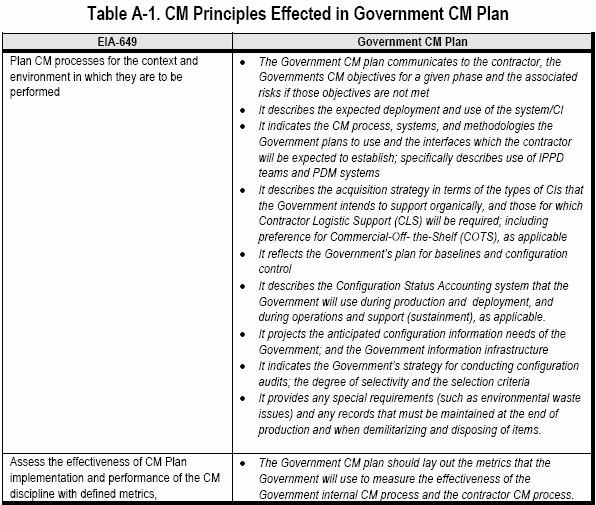MIL-HDBK-61A: Configuration Management Plans
< Previous | Contents | Next >
A.2 Principles and Concepts
As described in Section 4, CM planning is a vital part of the preparation for the next phase of a program life cycle. The configuration management plan documents the results of that planning to enable it to be communicated and used as a basis in managing the program configuration management activities.
The Government CM Plan may be documented as a standalone document, or it may be combined with other program planning documents. It has a two-fold purpose. The first purpose is to document the planning for the Government CM activity to take place during the upcoming phase and to schedule specific actions necessary to implement those activities. The second purpose is to communicate and coordinate the Government's intentions with the contractor or contractors involved in the program so that efficient and effective interfacing processes and working relationships may be established.
The government CM plan should be used as a repository for the ideas, schedules, actions and agreements that drive the activity during a given phase, including such elements as interface agreements, MOUs, system development, process documentation, operating procedures and training. Along with specific operating procedures, the CM plan provides guidance to the consistent application of CM across multiple integrated process and product development teams. It should also be used as a place to capture and evolve information that can be used to evaluate contractor activity, record specific experiences and document lessons learned.
EIA Standard 649 contains some practical guidance that is applicable for the Government as well as for contractors, as illustrated in Table A-1.
In preparing a Government CM Plan, it should not be necessary to "re-invent the wheel" for each phase of every program. Information developed in prior phases, and in prior programs can be used effectively as source material, where appropriate. However, a careful analysis of the needs of the particular phase is necessary to avoid the implementation of any activity that would not add value. The CM Templates in Section 2 should be used as guides/shopping lists to aid in the selecting appropriate activities and metrics.

Activity Guide: Table A-2 provides a topic by topic compendium of the subject matter that should be considered in preparing a Government CM plan for each of the four phases of a program life cycle. As with the configuration documentation, the CM Plan evolves from broad conceptual ideas for Phase 0 and Phase I to specific descriptions of mature and proven processes in Phase III.
In the past, the Government stated its requirements in RFPs by reference to MIL-STDs. Even though tailoring of the MILSTD was mandatory, it was often inadequately done. The contractor responded with a plan that cited compliance to the MIL-STD without disclosing significant details of how that compliance was to occur. The current environment is quite different. The Government states its formal requirements succinctly in the form of a Statement of Objectives. The contractor responds with a proposal containing a description of the processes that will be implemented and a SOW scoping the tasks to be performed. Seldom, however, particularly on major programs, are the formal proposal requirements the whole story. Typically there are several rounds of draft RFPs and communications sessions between Government and Contractor prior to the formal issuance of RFPs. The Government program personnel must complete their planning early in this cycle and can benefit from review and coordination with counterpart contractor personnel. Thus the contractor should know the content of the Government CM Plan. The contractor also formulates his planning in a similar time frame in order to be prepared to compare notes and provide meaningful input to the Government.
The Contractor's CM Plan, prepared or revised for a given phase, should reflect compatibility with the Government's plan. While both plans contain some common topic areas, they are addressed from different perspectives. The contractors CM plan also has a dual purpose. One purpose is to provide the framework for the contractor's application of CM on the specific program in order to manage the configuration of the product in a prudent and efficient manner. The other purpose is to provide the Government with assurance that the Government interfaces and information needs will be satisfied, and that a product of known and documented configuration will be delivered, and in many cases maintained. The CM Plan should describe the contractor's CM objectives, the value adding CM activities that will be employed to achieve them, and the means of measuring and assuring that they are effectively accomplished.
There have been many definitions of CM Plan content over the years. EIA Standard 649 contains a generalized description of CM plan content without dictating any specific sequence of information. It is important that the CM Plan convey information at an appropriate depth for the specific program environment.
Activity Guide Table A-3 should provide no surprises to the experienced CM practitioner. As with the Government plan, the Section 2 CM Templates provide guidance in evolving the specific objectives, activities, information and metrics to be described in the plan.
For correct application of this information, see NOTE on Contents page